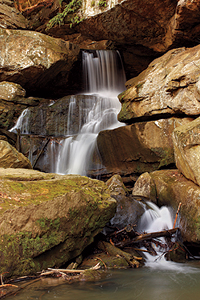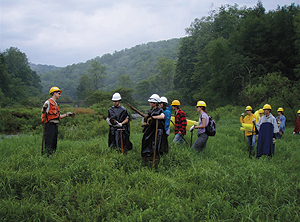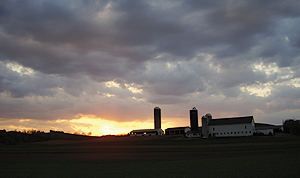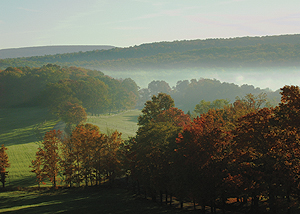Conserving Regional Treasures: Forests, Rivers and Streams

WPC’s conservation efforts helped form state parks such as McConnells Mill, which features Breakneck Falls.
Western Pennsylvania’s future depends on the health of its forests, rivers and streams. These natural resources contribute significantly to the area’s economy and quality of life, as well as sustain locally and globally important ecosystems and wildlife.
Forests are renewable resources that contribute almost $5 billion annually to the Pennsylvania’s economy. They serve as popular outdoor destinations for hikers, hunters and wildlife-watchers and they support more than 10,000 species of plants and animals and other important forms of life. Pennsylvania’s vast network of streams and rivers support a wide variety of freshwater organisms, contain many rare species and include the headwaters of the great but imperiled Chesapeake Bay and the Gulf of Mexico.
The Western Pennsylvania Conservancy has contributed to the preservation of this rich natural legacy. The organization has protected or restored more than 1,500 miles of rivers and streams and has conserved more than 233,000 acres – almost one-half of all land protected by land conservation organizations in the state. Ten of Western Pennsylvania’s beloved state parks – including Ohiopyle, Laurel Ridge, McConnells Mill, Moraine, Oil Creek and Erie Bluffs – were formed in part as a result of the WPC’s conservation efforts.
WPC has identified lands and waters that, if protected, will maintain the region’s native plants, animals and ecosystems. Guided by scientists and partners, the Conservancy works to conserve and restore lands and waters that have ecological and recreational value.
WPC uses a range of conservation tools to protect lands, including purchase, lease agreements and conservation agreements with private landowners.
WPC’s Watershed Conservation Program is dedicated to watershed conservation issues and to providing a full range of services to the community. The Conservancy participates in a range of water conservation efforts including watershed conservation plans, watershed restoration projects, bathymetry initiatives, water trail mapping and algae studies.

Workers prepare for a planting near Spring Creek.
The Conservancy’s actions have made a lasting impact, but there is much more to be done. Western Pennsylvania still contains magnificent, large natural areas with ecological, scenic and recreational values that should be conserved for future generations. However, their numbers are dwindling. These lands face numerous threats including rapid land consumption, division of rural properties into fragmented small parcels, poorly executed extraction of natural resources, and unplanned development.
The region’s streams, rivers and lakes also face challenges that threaten the quality and quantity of water that will remain for future generations. Even as the region continues to repair damage to the rivers and streams caused during the previous century, these resources face new and significant threats due to numerous pollution sources and, in some areas, unsustainable usage levels.
It is vitally important to conserve these magnificent and ecologically important rivers, streams and natural places at a large scale that will address these urgent challenges – while there is still time.
The Conservancy is poised to lead these efforts. The organization will focus on conserving and restoring the region’s highest-valued natural resources:

WPC uses many conservation tools to protect lands, including agricultural easements.
- • Habitat for endangered plants and animals;
- • Diverse woodlands and large forest expanses that can help protect water resources, create wildlife corridors and improve air quality; and
- • Creeks, streams and lakes that provide recreational opportunities, drinking water and shelter for wildlife.
While the Conservancy’s land and water conservation efforts will continue throughout the region during the coming decade, much of WPC’s work will target four key protection areas.
In the Central Valleys and Ridges, WPC aims to:
- • Protect forestland, focusing on large tracts adjacent to Buchanan, Rothrock and Bald Eagle state forests and Blue Knob State Park;
- • Conserve high-value natural areas in the Sideling Hill Creek watershed, around Canoe Creek State Park and in the Nittany Valley; and
- • Protect 200 miles of streams and restore wildlife habitat through better agricultural conservation practices, enhanced management of dirt and gravel roads and improved on-lot wastewater disposal systems.
Along French Creek and the Lake Erie Shoreline, goals include:

WPC has conserved more than 233,000 acres in Pennsylvania, including this Laurel Highlands parcel in Cook Township.
- • Conserving lands such as glacial lakes and wetlands, floodplain forests and land along the Lake Erie shoreline;
- • Protecting key areas on the French Creek floodpla
- • working in collaboration with local land trusts to build capacity at the community level; and
- • Continue working with private landowners to address sediment pollution throughout the French Creek watershed, building partnerships and leveraging funds to extend watershed conservation.
In the Laurel Highlands, WPC aims to:
- • Conserve land with natural and recreational value, as well as working forestland and farmland, focusing on Chestnut Ridge, Laurel Ridge, the wild Youghiogheny River corridor, Mount Davis – Pennsylvania’s highest point – as well as scenic areas, working forests and farms in the Ligonier Valley;
- • Enhance the ecological and recreational value of our own 5,000-acre Bear Run Nature Reserve, which encompasses Fallingwater and provides a vast natural buffer that protects the pristine mountain stream Bear Run; and
- • Protect and restore 150 miles of streams, implementing best management practices on farms and dirt roads in the Tubmill Creek and Loyalhanna Creek watersheds; enriching the Bear Run ecosystem and enhancing the natural and recreational value of the Youghiogheny River.
WPC’s goals for Pennsylvania’s Northern Woods include:
- • Protect large tracts of working forestland that improve access to state forests, parks and game lands and increase opportunities for the public to enjoy the region’s streams and rivers;
- • Conserve valuable forest resources through conservation easements with landowners. These agreements promote conservation on private, working forests and provide for sustainable management of valuable timber resources; and
- • Protect 250 miles of streams by undertaking abandoned mine drainage treatment programs, promoting better management of runoff and restoring fish habitat.
